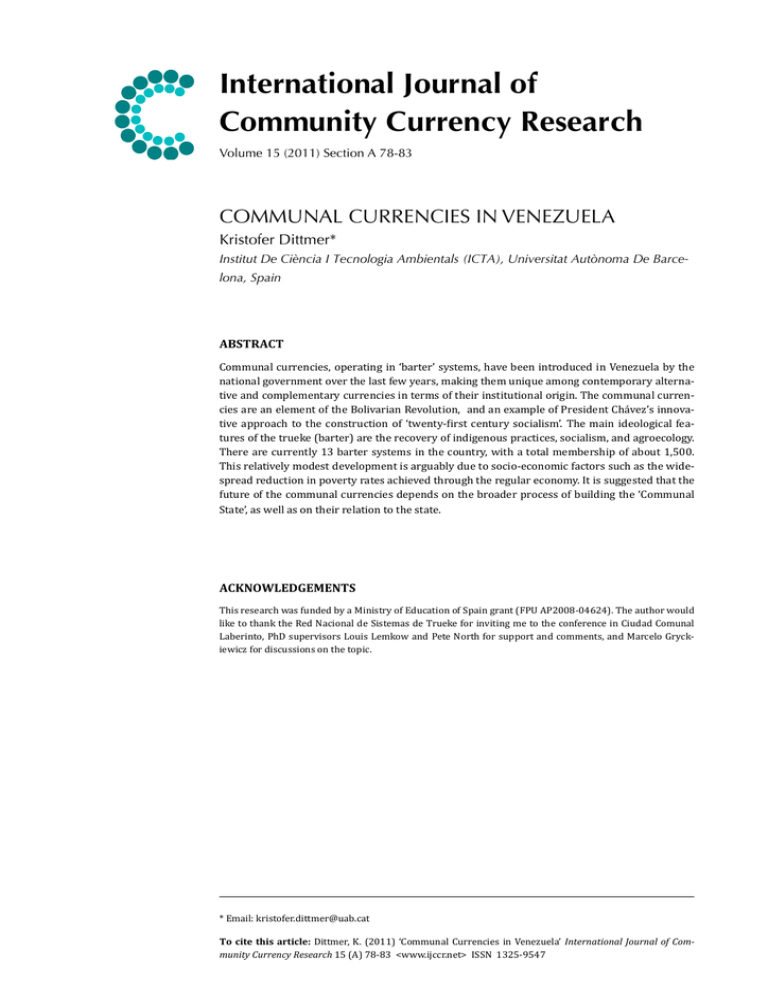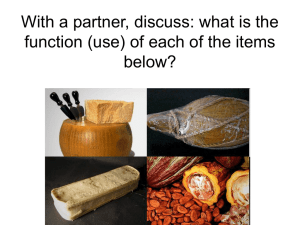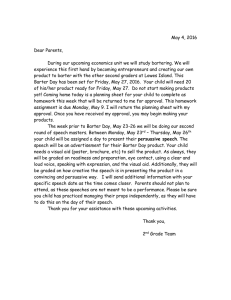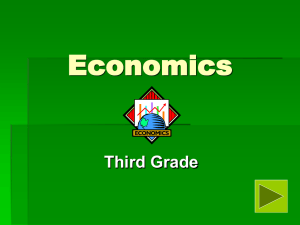IJCCR 2011 Dittmer
advertisement

International Journal of Community Currency Research Volume 15 (2011) Section A 78-83 COMMUNAL CURRENCIES IN VENEZUELA Kristofer Dittmer* Institut De Ciència I Tecnologia Ambientals (ICTA), Universitat Autònoma De Barcelona, Spain ABSTRACT Communal currencies, operating in ‘barter’ systems, have been introduced in Venezuela by the national government over the last few years, making them unique among contemporary alterna-­‐ tive and complementary currencies in terms of their institutional origin. The communal curren-­‐ cies are an element of the Bolivarian Revolution, and an example of President Chávez’s innova-­‐ tive approach to the construction of ‘twenty-­‐Girst century socialism’. The main ideological fea-­‐ tures of the trueke (barter) are the recovery of indigenous practices, socialism, and agroecology. There are currently 13 barter systems in the country, with a total membership of about 1,500. This relatively modest development is arguably due to socio-­‐economic factors such as the wide-­‐ spread reduction in poverty rates achieved through the regular economy. It is suggested that the future of the communal currencies depends on the broader process of building the ‘Communal State’, as well as on their relation to the state. ACKNOWLEDGEMENTS This research was funded by a Ministry of Education of Spain grant (FPU AP2008-­‐04624). The author would like to thank the Red Nacional de Sistemas de Trueke for inviting me to the conference in Ciudad Comunal Laberinto, PhD supervisors Louis Lemkow and Pete North for support and comments, and Marcelo Gryck-­‐ iewicz for discussions on the topic. * Email: kristofer.dittmer@uab.cat To cite this article: Dittmer, K. (2011) ‘Communal Currencies in Venezuela’ International Journal of Com-­ munity Currency Research 15 (A) 78-­‐83 <www.ijccr.net> ISSN 1325-­‐9547 International Journal Of Community Currency Research 2011 Volume 15 (A) 78-83 Dittmer ies of these laws were the marginalized sectors of Vene-­‐ zuelan society, especially workers in the informal economy, non-­‐unionized employees in small Girms, and the rural workforce (Ellner 2008). This radicalization of the Bolivar-­‐ ian Revolution intensiGied the polarization of Venezuelan society, uniting the opposition around the goal of ousting Chávez from power. A number of means were used for this purpose -­‐ all of which failed -­‐ including the coup attempt of April 2002, which was defeated after two days owing to Chávez’s widespread support among the popular classes and within the military, as well as divisions among the coup-­‐makers (Ellner 2008, pp. 112-­‐21). This was followed by a general strike in November 2002-­‐March 2003, which “was actually a combination of management lockout, ad-­‐ ministrative and professional employee strike, and general sabotage of the oil industry” (Wilpert 2007, p. 25). As the strike failed, the opposition turned to the Guarimba Plan in early 2004, promoting street violence and confrontation with security forces in a frustrated attempt to induce a mili-­‐ tary response that would overthrow the government and re-­‐establish order (Ellner 2008, pp. 120, 140). Finally, the opposition organized a presidential recall referendum in August 2004, which merely served to reassert the legiti-­‐ macy of the president, yielding 59% of the vote in his fa-­‐ vour (Ellner 2008, p. 120). Far from achieving their objec-­‐ tive, these insurgent tactics set in train a “dialectic of counter-­‐revolution and radicalization” (Wilpert 2007, p. 9) that drove Chávez increasingly to the left. Consequently, with the opposition weakened by the repeated failure of their counter-­‐revolutionary schemes, in January 2005 Chávez announced that the aim of the Bolivarian Revolution would be the construction of ‘twenty-­‐Girst century social-­‐ ism’. INTRODUCTION This article aims to introduce the reader to Venezuela’s communal currencies (monedas comunales) that are used in ‘barter’ systems (sistemas de trueke) and operate in parts of the country since 2007. The article is based on data gathered at the 6th National Meeting of Barter Systems (Ciudad Comunal Laberinto, Venezuela, 23-­‐26 June 2011), as well as other second-­‐hand sources. The article begins by outlining the Bolivarian Revolution, followed by an account of the emergence of the trueke as an element of this proc-­‐ ess. A short section on the legislation of the communal cur-­‐ rencies follows, after which the basic functioning of the systems is explained. After a description of the main ideo-­‐ logical features of the trueke, the article concludes by sug-­‐ gesting some preliminary explanations to the modest de-­‐ velopment of the communal currencies. It is hoped that this account will provide an initial understanding of Venezuela’s communal currencies and their future prospects. 1.1 The Bolivarian Revolution Venezuela’s communal currencies have developed with an unusual amount of government support, and should there-­‐ fore be understood as part of Venezuela’s Bolivarian Revo-­‐ lution, the outlines of which I will now sketch brieGly. In December 1998, in the wake of two decades of economic decline, widespread discontent with the neoliberal policies implemented since 1989, and the gradual break-­‐up of the ‘pacted democracy’ instated in 1958, Lieutenant Colonel Hugo Chávez was elected president after a campaign that centred on the need to elect a Constitutional Assembly to draft a new constitution that would create a Fifth Republic based on ‘participatory democracy’ (see e.g. Ellner 2008, Gott 2011, Wilpert 2007). Chávez’s political project has revived the legacy of Simón Bolívar, the hero of Latin Amer-­‐ ica’s independence wars against Spain, this time with the goal of liberating the continent from the economic and cul-­‐ tural rule of the United States, creating in its stead “a great Latin American and Caribbean union” (Chávez cit. in Gott 2011, p. 184). As one of the oil-­‐richest countries in the world, Venezuela seemed well placed to take the lead in this Bolivarian Revolution. Sure enough, among the main successes of the Chávez administration in its Girst year in ofGice was its consolidation of the OPEC, strengthening the cartel’s control over the oil price, the domestic parallel of which was a less successful effort to assert government control over the thoroughly corrupt state oil company, PDVSA (Gott 2011, pp. 169-­‐71). 2. THE EMERGENCE OF BARTER SYSTEMS IN VENEZUELA Venezuela’s barter systems are unique among contempo-­‐ rary alternative and complementary currencies in that the initiative for their creation was taken at the highest politi-­‐ cal level by President Chávez himself. Chávez Girst put his ideas for a complement to the national currency – the bolívar -­‐ into the public realm in his weekly televised pro-­‐ gram Aló Presidente on 18 December 2005, acknowledging Danielle Mitterrand, the widow of the former president of France, as the person who had introduced him to the topic. Mitterrand in turn had met Rubén Ravera and Carlos de Sanzo of Argentina’s Red Global de Trueque (RGT) (Covas et al. 2007). In the program, Chávez explained his ideas for local community currencies with a limited life span to deter accumulation. In recognition of the mixed origins of the concept of solidarity economy, or perhaps simply in the yuletide spirit of the broadcast, Chávez summed up his ideas thus: “Do you know what this is called? Socialism. Socialism. And even more, I say: Christianism” (Chávez 2005)1 . The following month in Caracas, the 6th World So-­‐ cial Forum served as the setting for the Girst public demon-­‐ The Girst two years of the Chávez presidency brought about the erosion of the political power-­‐centres of the old elite, such as the ministerial cabinet and the judiciary (Wilpert 2007, pp. 21-­‐2), but was relatively moderate in the eco-­‐ nomic realm. This was to change in November 2001 with the enactment of a package of 49 radical laws that signalled the deGinitive break with neoliberal socio-­‐economic policy. To the alarm of the privileged classes, the main beneGiciar-­‐ 1 An edited version of this explanation, which keeps the reference to socialism but not to Christianism, became the widely circulated promo-­‐ tional video La Parte Roja (The Red Part) (INAPYMI 2006). 79 International Journal Of Community Currency Research 2011 Volume 15 (A) 78-83 stration of a barter currency (called TXAI) in Bolivarian Venezuela, the result of a collaboration between the Minis-­‐ try of Popular Economy (MINEP) and Brazilian solidarity economy organizations (Primavera 2011). Later in 2006, Ravera and fellow RGT founder Horacio Covas were con-­‐ tracted by the National Institute for the Development of Small and Medium Industry (INAPYMI, attached to MINEP) to assist the creation of barter networks (Naishtat 2007). Also contracted in August 2006 were two coordinators of the Santa Elena barter system in Medellín (Colombia), Juan Esteban López and Pablo Mayayo, both of whom have re-­‐ mained deeply involved in the development of Venezuela’s barter systems. Dittmer ventures, as the Argentine Red de Trueque Zona Oeste had previously aspired to do (Gómez 2009). Accordingly, with the participation of 270 cooperatives, the MINEP piloted the mirandino currency during a 3-­‐day fair in September 2006 (Navarrete 2006). No permanent barter system materialized until June 2007, delayed in part by the campaign for the presidential elec-­‐ tions of December 2006 (J.E. López, interview). In April 2007, Chávez visited the rural municipality of Urachiche, and suggested that this would be an ideal place to set up a local barter currency (Chávez 2007b). The following month, López and Mayayo commenced training workshops, and on 17 June the newly created Sistema de Trueke de Urachiche held its Girst market (RNST 2010a). Two more barter sys-­‐ tems were established that year, and seven more emerged in the Girst semester of 2008 (one of which was subse-­‐ quently divided into a northern and southern system). This rate of growth, by far the highest in the Venezuelan experi-­‐ ence to date, was achieved “through a marathon effort by the facilitation team, local leaders, cooperatives, producers’ associations, Communal Councils, and government institu-­‐ tions that supported the process, such as INAPYMI, Misión Madres del Barrio [Mothers of the Barrio Mission], Misión Cultura, CONAC [National Council of Culture], among oth-­‐ ers” (RNST 2010a)2 . The following 4 October saw the foun-­‐ dation of the National Network of Barter Systems (Red Na-­‐ cional de Sistemas de Trueke, here RNST), and this day is since celebrated as National Barter Day, the ambition being to turn it into the Global No-­‐Money Day (RNST 2009a, p. 3). The purpose of the RNST is to function as a tool for mutual support and cooperation, organize national barter events and nation-­‐wide exchanges, and facilitate the formulation and upholding of a common policy (Wilpert 2011). The presidential interest in barter currencies at this stage of the Bolivarian Revolution can be understood in the con-­‐ text of Chávez’s dialectical radicalization and his reasser-­‐ tion of political authority following the defeat of the counter-­‐revolution, which left ample space for radical pol-­‐ icy experimentation, facilitated by the healthy state of pub-­‐ lic Ginances resulting from the economic expansion in proc-­‐ ess since 2003 (Weisbrot 2011). The willingness of the president to experiment with the nature of money, distin-­‐ guishing him from other leftist statesmen like Lenin and Trotsky who adhered to the sound money creed (Polanyi 2001, p. 26, Galbraith 1975, p. 42), makes sense in light of his intellectual sources, speciGically Simón Rodríguez, to whom it has been claimed that Chávez “owes more than to Marx or Castro” (Gott 2011, p. 210). Best remembered as Bolívar’s tutor, Rodríguez famously addressed the newly independent nations of ‘Spanish America’ thus (Cerutti Guldberg et al. n.d., 'Inventamos o erramos'): “Where would we look for models?... -­‐ Spanish America is orijinal [sic] = ORIJINAL must be its Institutions and its Government = ORIJINAL the means of building them both. After the founding boom in the Girst half of 2008, the pace of expansion slowed considerably. Only one system was successfully established in 2009, with another one discon-­‐ tinued after its inaugural market in December 2009 (J.E. López, interview). The year 2010 also saw only one new system emerge, yielding a total of 13 active systems at the time of writing (October 2011). either we shall Invent, or we shall Wander in Error.” Rodríguez’s call for inventiveness has been heeded by Chávez from the start of his political career (Gott 2011, p. 210), and it is also the source of the ‘semiotic insurgence’ that is evident in the Venezuelan barter systems’ preferred spelling of trueke (discussed below). 3. LEGISLATION OF THE TRUEKE President Chávez, who had long called for a barter law “to speed up the Gight against poverty and speed up the con-­‐ struction of socialism” (Chávez 2007a), eventually used an enabling law to dictate a decree on this matter, the publica-­‐ tion of which coincided with the conclusion of the founding boom in July 2008 (Bolivarian Republic of Venezuela 2008). The decree postulates a series of objectives and principles of ‘alternative systems of solidarity exchange’ and ‘solidar-­‐ ity exchange groups’, sets out the procedure for the creation of such entities, and deGines the rights and obligations of their members. Alternative systems of solidarity exchange are understood to comprise both direct and indirect barter, the latter being the mode that involves an alternative cur-­‐ rency, which it terms ‘communal currency’ (moneda comu-­‐ Chávez’s interest in barter currencies at this stage of the revolution can also be understood as a response to the government-­‐led cooperative boom that the country was experiencing, with annual ofGicial registrations of new co-­‐ operatives mushrooming from 2,280 in 2002 to 41,422 in 2005 (Fagiolo 2009). The government aimed to set up an alternative currency to promote trading between coopera-­‐ tives, as well as between cooperatives and the public, so as to consolidate a socialist cooperative sector (Navarrete 2006). It was hoped that barter currencies would provide seedbeds for the development of (cooperative) business 2 Missions are social programs Ginanced by the government. 80 International Journal Of Community Currency Research 2011 Volume 15 (A) 78-83 nal). It asserts that a communal currency “will only have value within the territory of its locality” (Art. 28) and will not circulate on a national scale, and that its value should be set at equivalence with the bolívar. The decree prohibits “Ginancial practices, such as charging interest or commis-­‐ sions” within alternative systems of solidarity exchange (Art. 11). To implement the decree, a subsection of the Min-­‐ istry of Communal Economy (MINEC, formerly MINEP), the OfGice for Socio-­‐productive Communitarian Organizations, is assigned the function of registering and supervising soli-­‐ darity exchange groups (i.e. barter systems). In December 2010, the decree is replaced by a law passed by the Na-­‐ tional Assembly, which maintains the contents of the decree with minor changes (Bolivarian Republic of Venezuela 2010). Dittmer 200 units, as do families that sign up as a single member. The bolívar is, in principle, not used as means of exchange in the markets, and conversion between the national and local means of exchange is not allowed. Although the law states that “the value of the communal currency will be determined in equivalence to the money of legal tender” (Bolivarian Republic of Venezuela 2010, Art. 55), the RNST unsuccessfully asked for this formulation be modiGied so as to prescribe a relation of initial equivalence only (RNST 2010b). 5. IDEOLOGICAL FEATURES: INDIGENITY, SOCIAL-­ ISM, AND AGROECOLOGY Venezuela’s barter systems are a highly political phenome-­‐ non. Three themes stand out in the discourse of the RNST: the recovery of the ancestral practice of barter in pre-­‐ Columbian America; barter as an element of twenty-­‐Girst century socialism; and the advancement of agroecology and the quest for food sovereignty. Following Simón Rodríguez, the indigenous theme is apparent even in RNST’s preferred spelling of barter: trueke instead of the conventional true-­‐ que, whereby they manifest their desire for “independence from the Spanish Royal Academy of Language and its anti-­‐ quated and impractical spelling rules, which have never made sense nor been of use to the speech and marvellous languages of these Amerikan [sic] lands” (RNST n.d.). To practice barter is to recover a part of “our native civiliza-­‐ tions [which] always knew to live better and had (and have) a lot more knowledge and wisdom (in all aspects) than Occidental civilizations, which the only thing they did was to invade us, breaking our millennial historical vector, bringing pain, backwardness and obscurantism to our sa-­‐ cred earth” (RNST n.d.). The indigenous theme was pro-­‐ moted from the outset by López and Mayayo (J.E. López, interview), and is evident in the names of many of the communal currencies, together with vindications of Afro-­‐ Caribbean history and culture, as in the momoy (indige-­‐ nous mythological being), the cimarrón (fugitive slave), and the zambo (person of mixed African and Amerindian ori-­‐ gin). 4. BASIC FUNCTIONING OF THE BARTER SYSTEMS Trading in the barter systems is primarily based on peri-­‐ odical community markets. Unlike the largely urban Argen-­‐ tine barter clubs (Gryckiewicz 2011, see also Gómez 2009, North 2007), the established Venezuelan barter systems are predominantly rural, with markets mostly held in vil-­‐ lages and small towns. This may be explained by the focus on the trueke as a means of facilitating food sovereignty, as discussed below. Consequently, agricultural produce, espe-­‐ cially moderately perishable fruits and vegetables, consti-­‐ tutes a large proportion of the goods on offer. The fre-­‐ quency of market events vary from once every two weeks to once a month, and this temporality is also inGluenced by rural factors, such as harvest cycles and large travel dis-­‐ tances (M.C. Barreto, conference). New members are required to attend an induction work-­‐ shop, in which they are familiarized with the ‘attitudes of the good prosumer’, as established in handbooks and monthly RNST bulletins, as well as with the legal frame-­‐ work and its declaration of moral principles, rights, and obligations (J. Laurito, conference). Since 2009, a standard-­‐ ized member registration form is used to compile catego-­‐ rized offers and wants, and to conGirm the commitment of the signatory to a series of stated principles and values of solidarity exchange (cf RNST 2009b, p. 6). In spite of the introduction of this instrument, the number of active mem-­‐ bers in the barter systems is quite uncertain. A recent esti-­‐ mate by one of the RNST spokespersons is that total mem-­‐ bership is at about 1,500, with an average of 120 active participants per system (J.E. López, pers. comm.). The par-­‐ ticipation of cooperatives and other social enterprises is rather weak, despite the recruitment efforts made by some barter systems (T. Quiroz, conference). While the indigenous and Afro-­‐Caribbean themes are ap-­‐ parent on the front of many of the communal currencies, the socialist, anti-­‐capitalist motif is articulated in the text that all systems reproduce (with minor changes) on the back of their notes: “This Communal Currency or Barter Facilita-­‐ tor is social property and is only valid for the ‘Prosumers’ (Producers and Consumers at once) of the [name] Barter System where it remains, identiGies, and binds together. In order to advance self-­‐management, new members are expected to participate in any one of the committees that make up the organizational structure of the systems, such as logistics, communications, quality and values, account-­‐ ing, and training (J. Laurito, conference). Individual mem-­‐ bers are freely given 100 communal currency units when signing up, and are asked to return the same amount if they leave the system. Although practices may vary from one system to the next, collective enterprises generally receive It acts as a tool that assists the barter of pro-­‐ portional products, services and knowledges within the System, without accumulating, in a spirit of self-­‐management and socialism. It does not yield interest. On no grounds may it be exchanged for money. 81 International Journal Of Community Currency Research 2011 Volume 15 (A) 78-83 The Prosumers of the [name] Barter System, Bolivarian Republic of Venezuela, Union of Nations of the South, believe that our fulGill-­‐ ment as human beings does not have to be conditioned by money or capital. We main-­‐ tain that it is possible to replace competition and vile selGishness with cooperation and reciprocity between people.” (adapted from Sistema de Trueke Merideño, 2009 ed. note) Dittmer 6. CONCLUSION Four years after the inauguration of the Girst permanent communal currency, the participation in Venezuela’s barter systems – estimated at 1,500 members – still pales in com-­‐ parison with the 80-­‐100,000 people reached in Argentina after three years (Pearson 2003) -­‐ one year before the ex-­‐ pansion that followed on the launch of the controversial ‘social franchise’ starter kit in 1999 (Powell 2002), and long before massive impoverishment saw participation peak at a frantic 2.5 million or so in 2002 (Gómez 2009, pp. 107, 113). The main reasons for this disparity are arguably socio-­‐economic. Argentina’s trueque grew on the back of the economic decline of the middle class -­‐ subsequently extending to the ‘structural poor’ as the crisis turned acute -­‐ and retracted partly as a result of the welfare payment introduced by the Kirchner government in May 2002, and the strong growth of the economy since 2003 (Gómez 2009, pp. 6-­‐7, 58-­‐9, 115-­‐118). In contrast, Venezuela’s communal currencies have been introduced in the thick of a revolution that has achieved a drop in the poverty rate from 43.9% in 1998 to 23.8% in 2009, with extreme poverty dropping from 17.1% to 5.9% in the same period (Weisbrot 2011). The agricultural produce of the trueke ‘competes’ with pub-­‐ lic soup kitchens and heavily discounted food products offered in a nation-­‐wide network of government-­‐owned grocery stores and supermarkets that numbered 16,626 in 2008 (Weisbrot 2011). Livio Rangel, one of the early promoters of the trueke, de-­‐ scribes it as “a political tool of the revolutionary process” that aims to strengthen the organizational capacity of the Chavistas and constitute a space where social relations based on solidarity can develop, building a socialist, com-­‐ munal economy (Rangel 2010). Although the initiative to introduce communal currencies came from President Chávez, and the barter systems have developed with sub-­‐ stantial organizational and Ginancial government support, the RNST expresses a desire that the barter systems may become entirely self-­‐managed, with no more government involvement (Wilpert 2011). In this regard, Rangel believes that “there is a maturity in the state, and in some public ofGicials, [to understand] that at this stage of the Venezue-­‐ lan revolution, the state should put itself in accord with the strengthening of the popular movement” (Rangel 2010). Rangel recalls Chávez’s words when he Girst made public his ideas for barter currencies, that they “will be in the hands and soul of the people, with its good judgement; they will be the system, the communities” (Chávez 2005). Re-­‐ Glecting the complexity of the challenges involved, one of the RNST spokespersons laments that the Ministry has not been sufGiciently active in promoting the creation of barter systems, but also that “many people do not understand that the barter systems ought to be self-­‐managed” (Wilpert 2011). In spite of plentiful government support, Venezuela’s com-­‐ munal currencies have made little headway in a society where almost every long-­‐forsaken corner is now awash with oil money, contrasting with the conditions of popular monetary drought under which alternative currencies prosper, as in Argentina of the early 2000s, or Greece today (Donadio 2011, Sotiropoulou 2011). Still, if the construc-­‐ tion of the ‘Communal State’ advances (Reardon 2010), so that communes and communal councils are given a larger organizational role in the allocation of goods and services, the trueke may gain importance as an allocative mecha-­‐ nism. Whether this could bring more local circuits of pro-­‐ duction and consumption, independent from the oil econ-­‐ omy, rather than merely an alternative system of distribu-­‐ tion of national produce and imports, remains to be seen. Furthermore, the future position of the trueke on the spec-­‐ trum from autonomous social movement to clientelist insti-­‐ tution is uncertain. On this probably depends whether or not it would have the resilience to live up to its ambition of being “the rearguard of the revolution” (P. Mayayo, confer-­‐ ence). The third theme espoused by the RNST is the link between barter systems and the quest for food sovereignty and the dissemination of agroecological practices. According to Rangel, the counter-­‐revolutionary ‘general strike’ in 2002-­‐ 2003 exposed the vulnerability of Venezuela’s system of food distribution to political sabotage, and this experience motivated the ambition to establish barter systems in areas of high agricultural potential, in zones of resistance able to face up to the situation of permanent global threats to the revolution (Rangel 2010). In line with its celebration of ancestral practices, the RNST calls for the revival of the conuco (traditional smallholding), and the exchange of part of its produce through the barter systems (RNST 2009a, p. 5). The RNST also embraces agroecology and permaculture, organizing nation-­‐wide exchanges of traditional seeds and agricultural knowledges. Although its vision is the estab-­‐ lishment of ecologically respectful local economies (J.E. López, interview), the present spatial pattern of barter sys-­‐ tems and the frequency of their interrelations probably owes more than they would like to the national abundance of cheap oil. REFERENCES Bolivarian Republic of Venezuela 2010, 'Ley Orgánica del Sistema Económico Comunal', Gaceta OGicial No. 6,011 Ex-­‐ traordinario, Caracas. Bolivarian Republic of Venezuela 2008, 'Decreto No. 6,130, con Rango, Valor y Fuerza de Ley para el Fomento y Desar-­‐ rollo de la Economía Popular', Gaceta OGicial No. 5,890 Ex-­‐ traordinario, Caracas. 82 International Journal Of Community Currency Research 2011 Volume 15 (A) 78-83 Dittmer Cerutti Guldberg, H., Magallón Anaya, M., Palacios Contre-­‐ ras, I. & Ramírez Fierro, María del Rayo (eds) n.d., Diccion-­‐ ario de FilosoGía Latinoamericana, Universidad Nacional A u t ó n o m a d e M é x i c o . A v a i l a b l e : http://www.cialc.unam.mx/pensamientoycultura/bibliotec a%20virtual/diccionario/index.htm (accessed 2011-­‐10-­‐ 24). Polanyi, K. 2001, The Great Transformation: The Political and Economic Origins of Our Time, Beacon, Boston. Chávez, H. 2007a, Aló Presidente No. 280, 29 March 2007. Primavera, H. 2011, 'La monnaie réinventée: quelques leçons de l’Amérique Latine', Presentation at the Interna-­‐ tional Conference on Community and Complementary Cur-­‐ rencies, Palais de la Mutualité, Lyon, 17 February 2011. Powell, J. 2002, 'Petty capitalism, perfecting capitalism or post-­‐capitalism? Lessons from the Argentinean barter ex-­‐ periments', Review of International Political Economy, vol. 9, no. 4, pp. 619-­‐649. Chávez, H. 2007b, Aló Presidente No. 283, 22 April 2007. Chávez, H. 2005, Aló Presidente No. 242, 18 December 2005. Rangel, L. 2010, Interview in 'Minga!', Radio Universidad, M e n d o z a , 1 7 O c t o b e r 2 0 1 0 . A v a i l a b l e : http://www.laventolera.org.ar/videos/44/427-­‐minga-­‐al-­‐in dividualismo (accessed 2011-­‐10-­‐24). Covas, H., De Sanzo, C. & Ravera, R. 2007, En el 12o aniver-­‐ s a r i o d e l C l u b d e l T r u e q u e . A v a i l a b l e : http://www.autosuGiciencia.com.ar/shop/detallenot.asp?n otid=1031 (accessed 2011-­‐10-­‐24). Reardon, J. 2010, 'Venezuelan National Assembly passes people’s power “Law of Communes"', venezuelanalysis.com, 13 December 2010. Donadio, R. 2011, 'Battered by economic crisis, Greeks turn to barter networks', The New York Times, 1 October 2011. RNST n.d., 'Por qué escribimos trueke con la letra "k"', Red Nacional de Sistemas de Trueke webpage, n.d. Available: http://rednacionaldetrueke.blogspot.com (accessed 2011-­‐ 10-­‐24). Ellner, S. 2008, Rethinking Venezuelan Politics: Class, Con-­‐ Glict, and the Chávez Phenomenon, Lynne Rienner, Boulder/ London. Fagiolo, M. 2009, 'La inGluencia de la renta petrolera en el desarrollo de la economía social en Venezuela, 1998-­‐2009', CAYAPA Revista Venezolana de Economía Social, vol. 18, pp. 93-­‐116. RNST 2010a, 'La historia de los sistemas de trueke en Venezuela', Red Nacional de Sistemas de Trueke webpage, 2 6 O c t o b e r 2 0 1 0 . A v a i l a b l e : http://rednacionaldetrueke.blogspot.com (accessed 2011-­‐ 10-­‐24). Galbraith, J.K. 1975, Money: Whence It Came, Where It Went, Houghton MifGlin, Boston. RNST 2010b, ModiGicaciones y aportes de la Red Nacional de Sistemas de Trueke al proyecto de Ley Orgánica para el Fomento y Desarrollo del Sistema Económico Comunal, Unpublished document. Gómez, G.M. 2009, Argentina's Parallel Currency: The Economy of the Poor, Pickering & Chatto, London. Gott, R. 2011, Hugo Chávez and the Bolivarian Revolution, 2nd edn, Verso, London/New York. RNST 2009a, Boletín Mensual de la Red Nacional de Siste-­‐ mas de Trueke, no. 4, July 2009. Gryckiewicz, M. 2011, Interview in 'Trueque y AutosuGi-­‐ ciencia', Radio RGT, Buenos Aires, 30 July 2011. Available: http://redglobaldetrueque.blogspot.com/2011/07/fotos-­‐d el-­‐viaje-­‐de-­‐marcelo-­‐gryckiewicz.html (accessed 2011-­‐10-­‐ 24). RNST 2009b, Boletín Mensual de la Red Nacional de Siste-­‐ mas de Trueke, no. 1, March 2009. Sotiropoulou, I. 2011, 'Alternative exchange systems in con-­‐ temporary Greece', International Journal of Community Currency Research, vol. 15, no. D, pp. 27-­‐31. INAPYMI 2006, La Parte Roja, Instituto de Desarrollo de la Pequeña y Mediana Industria, Caracas. Weisbrot, M. 2011, 'Venezuela in the Chávez years: its economy and inGluence on the region' in The Revolution in Venezuela: Social and Political Change under Chávez, eds. T. Ponniah & J. Eastwood, Harvard University Press, Cambridge/London, pp. 193-­‐223. Naishtat, S. 2007, 'Chávez importa los clubes de trueque', Diario Clarín, 29 January 2007. Navarrete, P. 2006, 'Ministry of Popular Economy pilots social currency', venezuelanalysis.com, 19 September 2006. Wilpert, G. 2011, 'Entrevista con Juan Esteban López, Red de Sistemas de Trueke', Fundación Rosa Luxemburg web-­‐ p a g e , 2 0 M a y 2 0 1 1 . A v a i l a b l e : http://www.rosalux.org.ec/es/analisis/venezuela/item/18 3-­‐trueke-­‐venezuela (accessed 2011-­‐10-­‐24). North, P. 2007, Money and Liberation: The Micropolitics of Alternative Currency Movements, University of Minnesota Press, Minneapolis. Pearson, R. 2003, 'Argentina's barter network: new cur-­‐ rency for new times?', Bulletin of Latin American Research, vol. 22, no. 2, pp. 214-­‐230. Wilpert, G. 2007, Changing Venezuela by Taking Power: the history and policies of the Chávez government, Verso, Lon-­‐ don. 83



